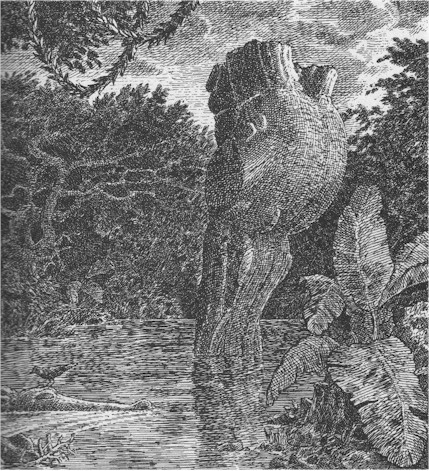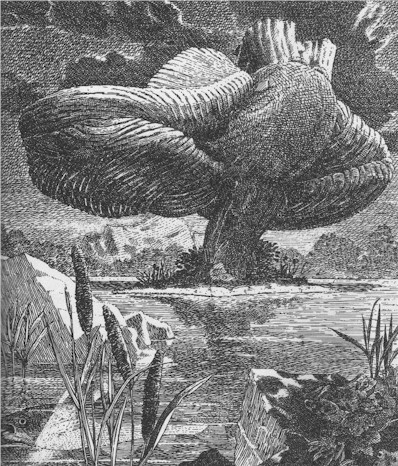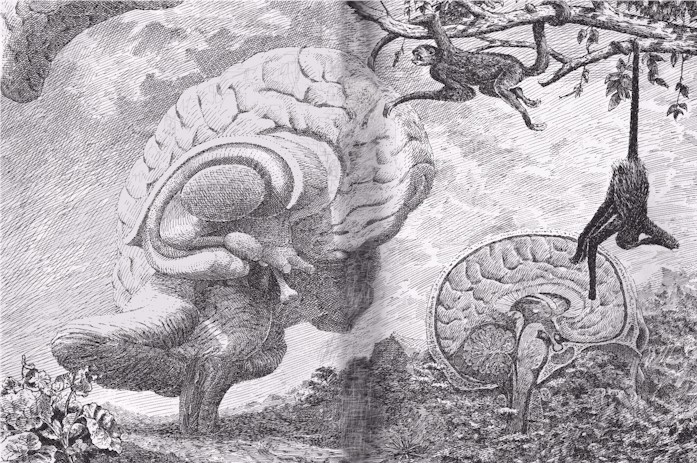Brain Evolution
One of the best things about being a living creature - organic, biologic - is that I have this very undeniable bias for beings like myself. For all living creatures, really. I simply - relate. In a deep empathizing way.
I -like- the essential dynamics and processes of what we are. How we are. That we are.
Its all pretty special. And a priveledge to experience.
One of the essentials which I've come to understand and appreciate, is a product of .. how we are architectured.
The reason I'm writing about this now ("again" actually; I wrote about it in my three1996 papers "Integrity - Consciousness" (Tucson II Towards a Science of Consciousness), "Consciousness Continuum", and "Maxwell's Demon and the Turing Test" ) is that I recently attended Douglas Hofstadter's symposium at Stanford University on the implications and impacts of humans possibly constructing thinking machines .. artificial intelligences .. and since then am involved in several internet discussions about it.
I hold a view of mind and sentience that is arguably "unique" from other stances out there. That is because Ceptual notions and Integrity ideas identify and describe a very important relationship about how the universe is organized to function.
It basically acknowledges that every event and action is essentially a sensorial event. Forces and behaviors don't just 'occur'. All forms and entities - sense, feel, and are aware (even if only in the most minimalized narrowly defined way) of what is going on - regardless of whether they are complex enough to 'report' those sensations, share those 'awarenesses', or are even capable of retaining a memory of any moment-of-feeling or engagement-in-enaction for themselves. These added components are the ones which we humans identify with first and foremost. But, they may not be the universe's criteria for 'essential sentience'. I certainly do not hold to them as standards.
The opening pages of "Understanding the Integral Universe", re-expressing the seminal concept of my 1973 paper on "Integrity", clearly express that communication and sensitivity-to-self and to-else have to be the most fundamental quality characteristics of 'universe'. Sensation and relation have to exist - even in the very fabric of Being at its simplest most fundamental levels of Presence (i.e., spacetime) - if it is to exist anywhere else at all, even up where we are and where our minds co-habitate with co-existence.
Beyond that, Ceptual percepts of 'universe' identify the situation that there are many simultaneous different inter- & intra- tiered coordinations of 'information' going on at any given time in any given systems, where, in the most freely integrated forms -- the ones that express through emergence and evolution in 'natural' ways -- are those in which the physical aspects ARE self-same with the meaningful information which they processes. In other words, yes, living systems 'process' extraneous information and energy, and in doing so 'survive' and 'proceed' in the world. But, just as important is the identification that any physical system IS an information source AND an information-sensitive sensor at the same time ; energy and information aren't 'carried', they are incorporated.
Science's new manipulators of atoms and energies, the AI science mechanics who devise artificial 'containers' to hold and capture and process 'information' as if the correct processing methods will transform the 'contained information' into 'wisdom', 'understanding', and even 'sentience', are missing the essential notion of what Being and Sentience are.
Living naturally-developed systems are sentient not because they move a lot of information around and somehow coordinate it successfully, but because living systems, now matter how complicated or simple, are affected by the energies that pulse through them, and which they are made of. They are not hardware unaffected by and indifferent to the software they carry - like bridges unaffected by whatever roadway traffic happens to pass on them. Instead, the image is more of one where every passing vehicle or walker has the potential of touching the bridge and the bridge sharing that encounter with every other bridge component, maybe even promoting responsive structural changes to other components with each step or change of location along the route. The bridge could reactively change how it's components are joined, or, cause the next coming touch-point to send a responsive back-pulse up into the vehicle or walker's body and make it bounce, where no bump in the road surface even existed a moment before. These are dynamic possibilities that do exist in natural systems - that expect and depend upon: any 'body' and any 'information' to interaffect one another, and by doing so the two effectively exist as a 'one' ; separation of hardware and software is not the hallmark of organic systems. Quite the opposite -- hardware in most instances is additional software/sourceware.
There is open sensitivity - vertically, laterally, and latticedly - allwhere though any and all assemblies of bodyform.
On the other hand, artificial intelligence, contrived intelligence, is not coordinated that way. Data streams are too well defined and are required to be informationally uncorrupted from source to destination. There is no flexibility or room for 'signal degradation' - or even - openness to acceptable but all important: 'variation'. The only way to accomplish the rigid model requirement under current schemas is to have carrier systems isolated just enough so that carried information will not affect the storing or processing hardware. The hardware has to be numb to the software. The hardware has to accept the storage states and change commands from an external source, and must play no role either happenstantially or by local purpose, in ever changing the externally required information states. Life takes a different tack - local information interplay, locally utile - is part of natural architecture.
So, now. What does this forbode for humanity? For us as a species still a player in the 'intertwined streams of evolving' modality? That's a real interesting question, especially when we use the past as a guide and try to project some likely alternative futures. Especially given the new rigid siliconic architecture of information handling, with its whole different style of relations.
As I'm writing this, I'm looking at the jacket cover of "The Amazing Brain" (Ornstein & Thompson, 1984), amazingly illustrated by David Macaulay. It's a pen and ink cross section of a human skull, rising like a tree-form out of a primeval forest. And my biology background gives me the sensation that I'm not just looking at some physiological structures juxtaposed in a strange landscape, but am projectively seeing the current status of historically (evolutionarily) recent brain parts resting atop and around previous ones that developed through the intensely long millenia of millions and millions of years of other animals lifeforms.
First there was just a simple bundle of nerve cells - a cordal spine. (see graphics,below) Then one end budded into brain stem, being what science currently refers to as the 'reptilian brain'. Next, and to the side a new structure appeared, the cerebellum, coordinator of muscles and simple memories. Atop these came the limbic grouping of organs, and after that came the cerebrum, which makes up most of the mass of present human brain volume.
The thing is, as a biologist and lover of things living and evolving, I have to ask this question: What's next? (smile). "Brain" is obviously not just a ballon structure, as in: want more 'brain'? .. just expand and blow-larger what you've already got. To some degree, that does work. But, if the evidence is correct, leaps in sentience seem to make the greatest strides by adding new structures, that accomplish new and better skills. (!)
So NOW lets look at AI again, with this new light of a situation in mind (and the ceptual criteria as well). And suddenly, an evolutionary divergence looms ahead of humanity. It's very possible we're poised on the threshhold of an evolutionary fork in the road, and it just might be worth while trying both (if not several).
I'm not particularly enamored of in-sensitive body-parts. I don't believe that a container IS what it contains. I don't see how my wholeness of sense/mind could be captured and housed in a numb-rigid artificial device and remain 'me'. But, I do see that what "I am" could be enhanced by adding components .. liking using night goggles that amplify natural light on the darkest night and bring previously unavailable information into my sensorial range and appreciate. It's quite possible that one evolutionary path for humanity is the addtion of siliconic components, to be the next brain structure after the cerebrum.
For my own 'druthers' (another option or choice) I'd rather see the emergence of some new natural brain organelles. I'd much rather see several new babies born with odd extra tissue in their brain cases .. and not have doctors unceremoniously excise them as if they were abnormalities .. instead of evolutionary trials. Who knows what new neural components are potentially coded for in current and future genetics? The only path I don't have patience for is one that locks in the status quo.
I do know that I don't consider 'immortality in an uncorruptable holding container' as commensurate with or appropriate with naturally continued open-development of sentience. It just doesn't seem naturally compatible or concurrent to me. But then, as I said, I've got this 'bias' about Life and the overarching essential quality the universe seems to have and enact as. More coordinated sensitivity seems to be the way of things, not less of it.. And though inert 'tools' do accomplish that in impressive localized ways, they do it at the expense of exploring native-potential for accomplishing any of those same things, by natural tissue exploration/adaptation (even if it takes longer to get there).
And then again, synthetic today, could be natural tomorrow. :-)





Images by David Macaulay from "The Amazing Brain" (1984).
Ornstein & Thompson. Houghton Mifflin, Boston
April 18, 2000